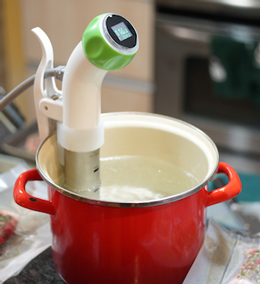Seeds of Disruption
How technology is remaking the future of food
Forecast Perspective: Satisfaction | Personalized Cravings
High-resolution biology ushers in a new science of food satisfaction

Findings from neurobiology, genetics, and other biological sciences are suggesting that the factors that make us satisfied—that make us feel that we got what we wanted out of food, be it satiety, taste, or other effects—vary by person, sometimes down to the cellular level. Knowledge of the myriad ways that people’s bodies metabolize fuel will spur new efforts to design foods not just for taste appeal but also to enhance energy, improve mood, and increase other long-term feelings of satisfaction. These efforts will converge with new attempts to design the context around food—including colors, smells, and sounds—to create eating experiences that satisfy the whole person.
Jump to:
Eating in this Future
Global Signals
Insights
Artifact from the Future
Download
EATING IN THIS FUTURE
- Direct-to-consumer genetic tests that detect factors having to do with nutrition—such as whether a person is better at metabolizing fats or carbs—gain in popularity, creating new interest in eating genetically appropriate diets. As these kinds of tests become widespread and gain sophistication, consumers become more interested in finding foods for their personal microbiome.
- Consumer demand for genetically appropriate foods places increased pressure on food manufacturers to create an increasingly wide variety of formulations targeted to specific biological needs.
- Other tools—such as cheap, ubiquitous sensors—enable both consumers and food researchers to begin to measure how contextual factors affect perceptions of taste and satisfaction. Such factors range from the timing of meals and snacks to environmental cues like scent and even music.
- Biological understanding of molecular satisfaction as well as the neuroscience of taste perception continue to advance over the next decade. In combination, these understandings drive manufacturing efforts toward creating multisensory food experiences designed to maximize overall feelings of satisfaction.
- These multisensory innovation efforts gain particular popularity as a means of delivering personalized medical and health nutrition. Such efforts aim first at giving patients with specific nutritional needs—such as diabetics—dramatically enhanced food experiences that also satisfy. Over time, similar innovations focus on other medical needs, such as enhancing taste and satisfaction among cancer patients undergoing chemotherapy.
- By the end of the decade, these tools are also put to more generalized health and well-being purposes, such as enhancing mood and energy. As this process accelerates, individual definitions of satisfaction expand and are dramatically reshaped. People increasingly come to value the personalized, functional benefits of foods alongside taste as part of an overall evaluation of satisfaction.
GLOBAL SIGNALS
United States
Bringing high-end cuisine to family kitchens

Leveraging communities on Kickstarter for funding, startups such as Nomiku have begun developing ways to bring sous vide cooking into the home. This technique, which was first developed at high-end restaurants, involves holding water at a precise temperature for slow, even cooking. Sous vide machines now retail for less than the cost of a good food processor, and have the potential to transform how individuals understand their own abilities to create satisfying foods.
Source: Nomiku
India
Combining Ayurveda with social media and biological sciences

Social media company Younomy published an “India Co-creates” report encouraging the Ayurveda industry to use social media to build communities of patients. Coupled with recent findings from electromyography and nerve conduction studies that measure the effects of Ayurvedic diets on physical health, the Younomy report argues that the convergence of biological sciences, social media and Ayurveda will usher in more personalized approaches to nutrition that have a broadly holistic appeal.
Source: India Co-Creates Ayurveda Industry. Younomy. 2012.
Japan
Creating Taste Illusions With Multisensory Technology

The “Hana Yakiniku” smartphone app aims to use senses other than taste to give people the illusion that they are eating meat when they are merely eating a plain bowl of white rice. Using a device called the Scentee, a smartphone hardware accessory that emits smells, and special scent cartridges, the app produces images, smells, and sounds of barbeque beef for the user. While bulky VR helmets that alter the wearers sense of sight and smell have proven capable of fooling people’s sense of taste in a laboratory, “Hana Yakiniku” represents an early attempt to mass market a less sophisticated version of such a device to consumers.
Source: Dinh, M. “Nose Yakiniku” brings Smell-O-Vision to your smartphone, promises to replace actual meat. Rocket News 24. October 2, 2013.
INSIGHTS
Defining new systems of eating with consumer electronics
In much the same way that the microwave transformed food preparation strategies, innovations in home and kitchen technologies will continue to reshape how people prepare and perceive food. And much like the microwave, the technology alone will be insufficient; rather, new packaged foods will emerge to enable individuals and families to take advantage of tools such as home sous vide cooking and define new ways of preparing high-end food at home.
Personalizing diets through taste and nutrition science
As new understandings of the effects of taste, as well as nutrition, emerge over the next decade, consumers will increasingly expect food not only to be healthy, but to taste good. As expectations of taste and health blend, foods will be increasingly customized to meet the personal needs and desires of an individual’s biology—including taste buds.
Creating new sensory food experiences
While we’ve always understood that other senses can impact the perceived taste of food, new understandings from neuroscience, coupled with technological tools to capture and convey scent and other senses, will expand the ways in which satisfying food experiences can be created. These multisensory experiences will serve as a means to enhance the quality of food and also lose weight and control food intake.
ARTIFACT FROM THE FUTURE
Virtual Reality In-flight Dining
 What: You’ve been making that six-hour flight from Los Angeles to New York every month for a year and you hit peak-peanut consumption long ago. You just got an email that you’re finally eligible for a free in-flight meal upgrade to the virtual reality dining service for tomorrow’s flight. You used to scoff at people wearing them, but after reading a few reviews online, it sounds like you’re actually in for a treat. A few people say that the virtual seared foie gras is better than any they’ve had in reality.
What: You’ve been making that six-hour flight from Los Angeles to New York every month for a year and you hit peak-peanut consumption long ago. You just got an email that you’re finally eligible for a free in-flight meal upgrade to the virtual reality dining service for tomorrow’s flight. You used to scoff at people wearing them, but after reading a few reviews online, it sounds like you’re actually in for a treat. A few people say that the virtual seared foie gras is better than any they’ve had in reality.
So What: The ability to directly and precisely manipulate the human senses will open a new frontier for creating food experiences. Initial attempts to rewire taste will likely be around curbing the hardwired drives for fats and sugars to improve health. However, as we develop a more nuanced understanding of both the chemical and psychological components that make up how we perceive food, people will start hacking the senses for many different goals—maximizing bliss, recreating nostalgic meal experiences, or making healthy, but bland, foods more enjoyable.
Download:
- SATISFACTION Forecast Perspective (PDF)
- Artifact from the Future - Virtual Reality In-flight Dining (JPG)